
Issue Contents

Photo Essay:
Traffic in Bhaktapur
Bhaktapur, Nepal, is like many other ancient cities. It was never designed to accommodate motorized vehicles, and its streets really are too narrow to permit much traffic without impinging on people and traditional uses of street space. This photo essay is simply a look at the streets in early 2016 as captured by Carfree.com's then-resident photographer, Ram Kumar K.C.
Fortunately, some long-standing restrictions on traffic in Bhaktapur were reinstated not long afterwards, with a consequent reduction in traffic generally and in the major historical squares in particular. There remains an uncomfortable amount of traffic. Some of it, mainly freight delivery, is more or less essential, although it would be possible to reroute at least some of that traffic in ways that would reduce its impact.
I don't want to overstate the seriousness of the situation, but street traffic, particularly fast-running motorcycles, was one of several reasons that I reluctantly left Bhaktapur. (Another was air pollution, a great deal of which is directly or indirectly related to motor vehicle traffic.) I hope that, as time passes, further restrictions will be placed on traffic in Bhaktapur and that this lovely city will regain its former tranquility.
Click on an image to open a bigger version in a new tab. Ctrl+w will close the new tab and return you to Carfree Times.
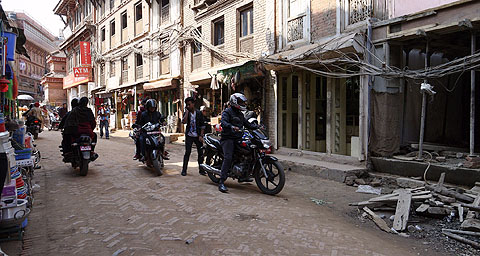

This and all other photographs by Ram Kumar K.C.
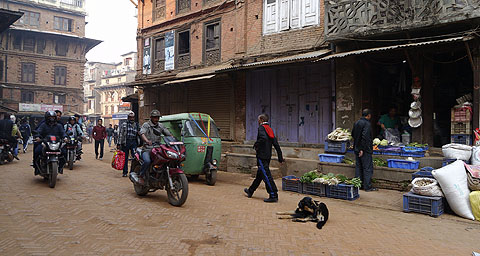

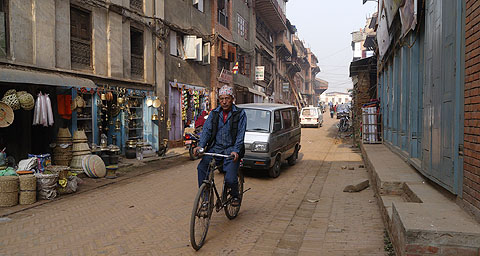

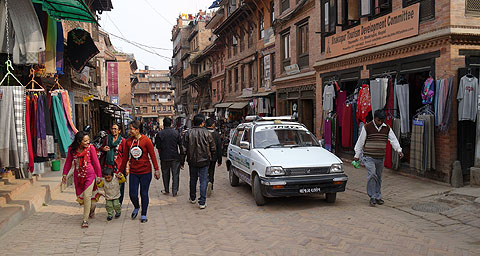

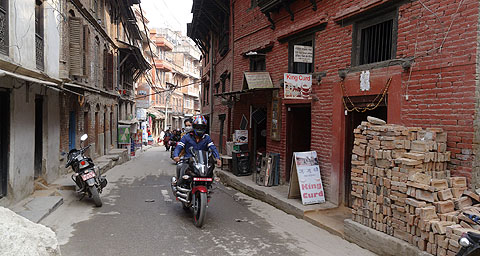

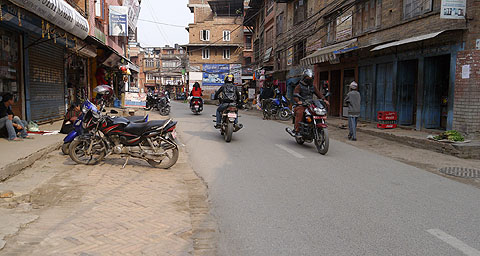

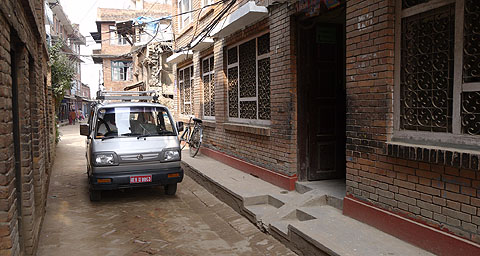

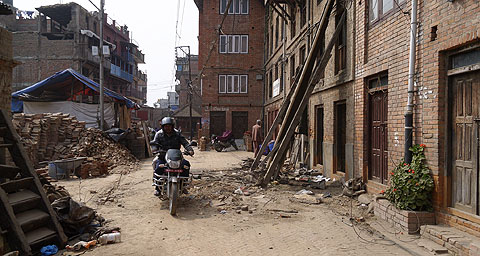

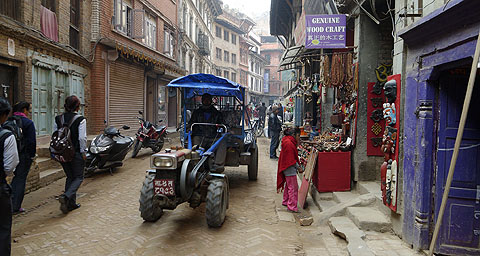

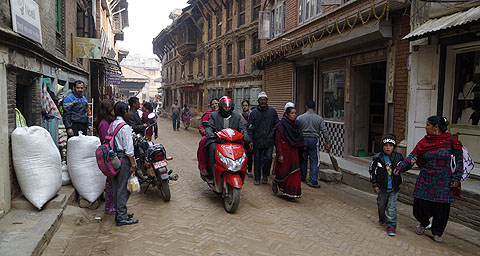

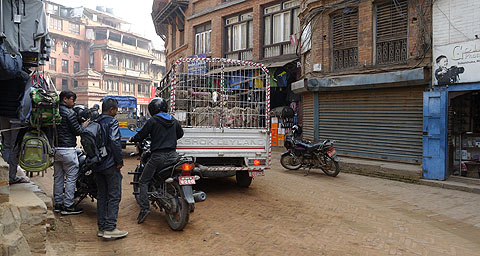

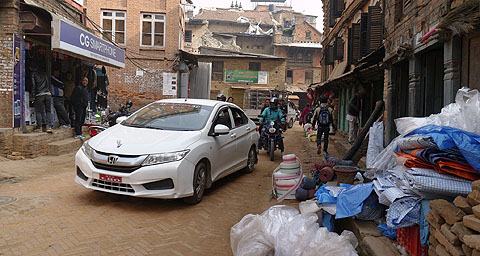

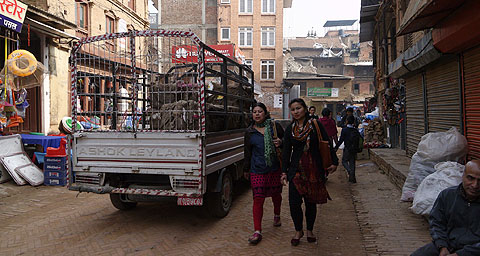

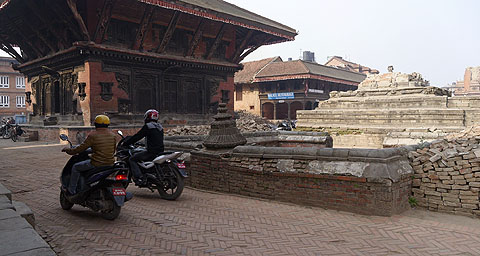

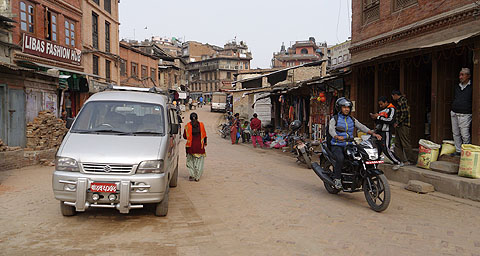

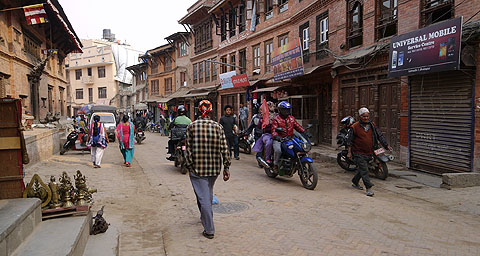

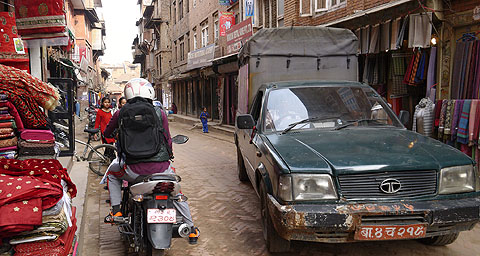

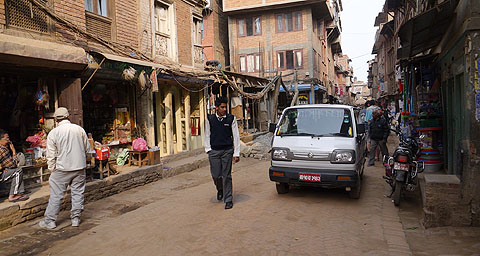

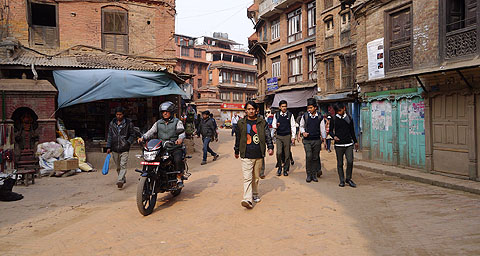

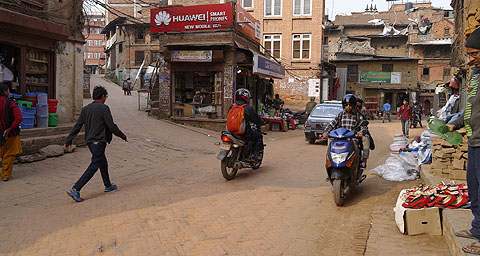

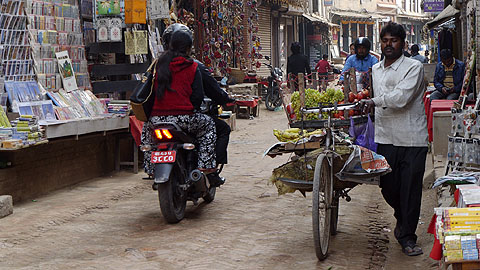

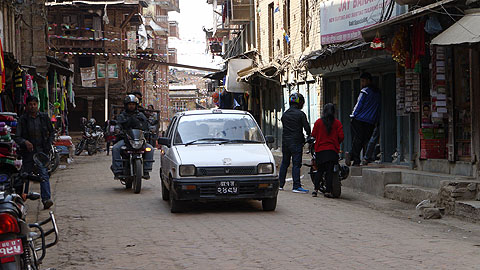

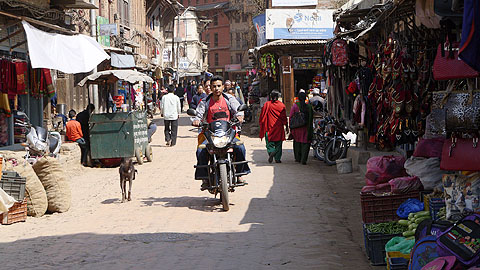

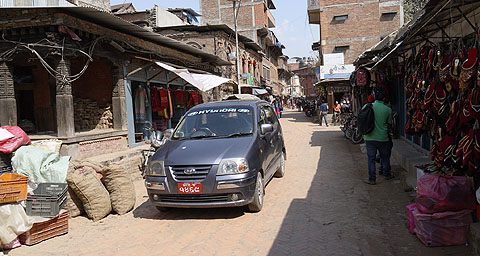

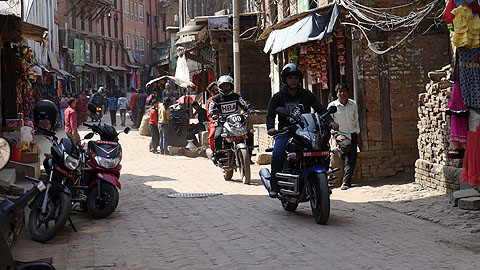

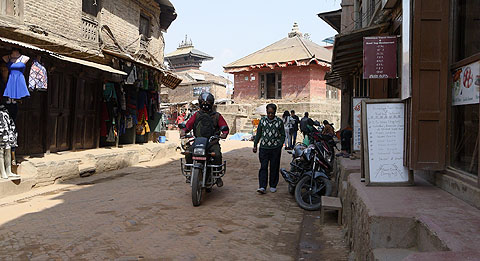

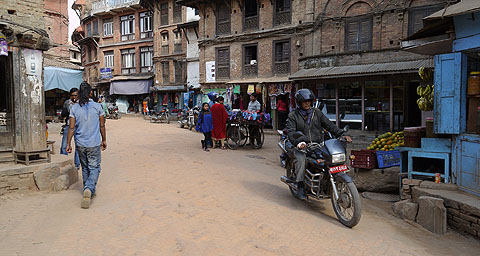

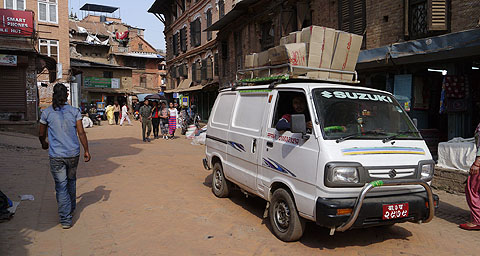

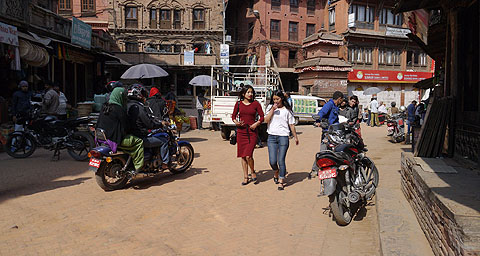

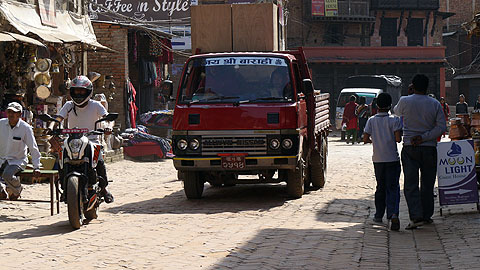

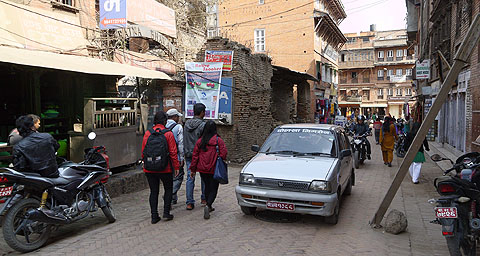

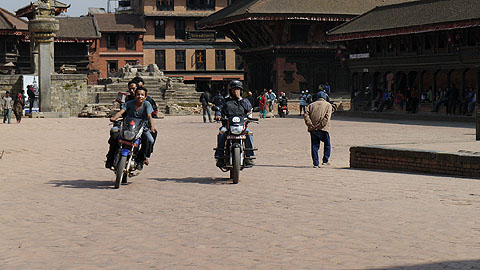

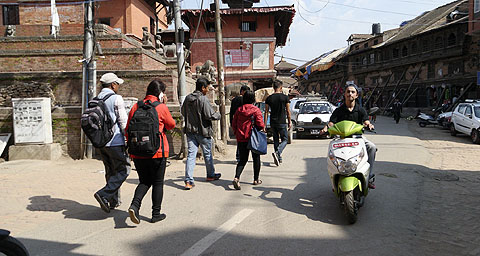

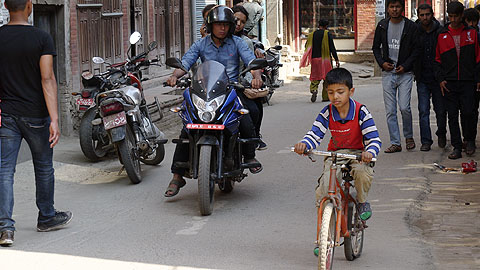

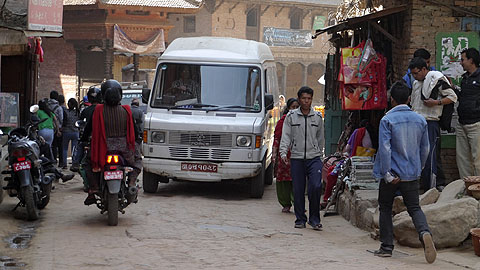

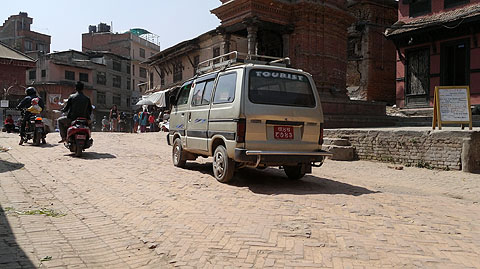

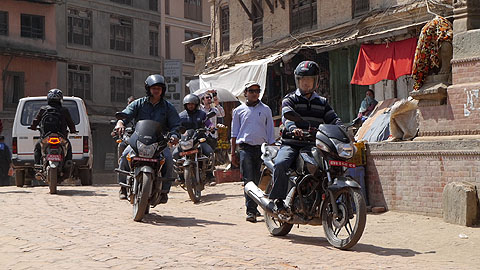

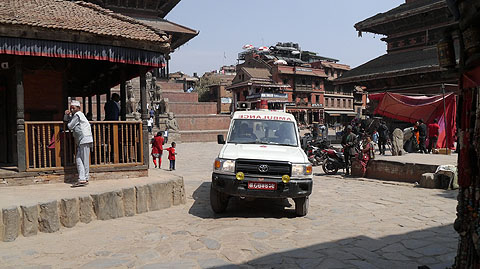

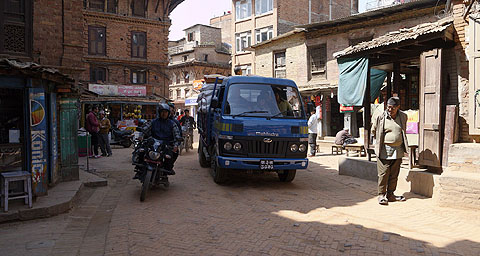

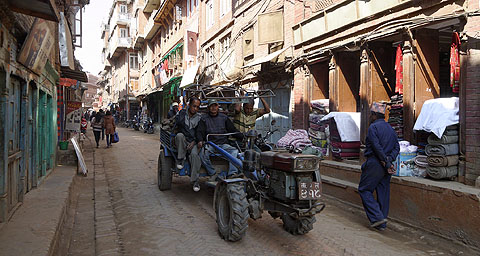

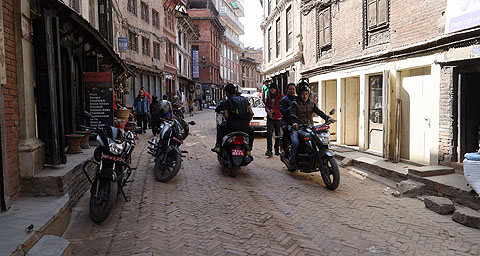

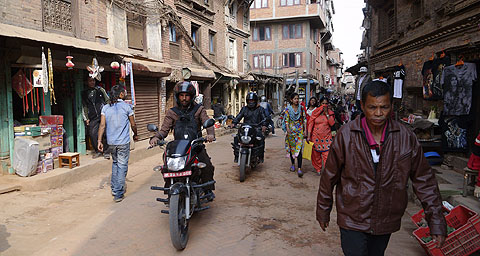

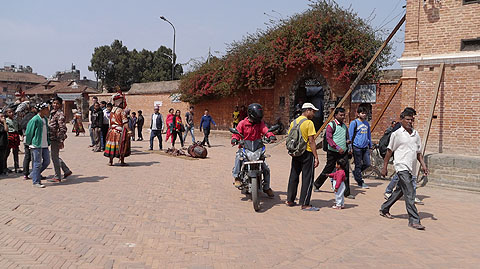

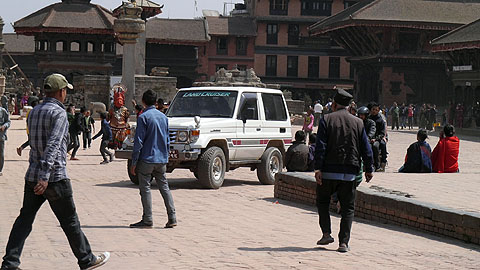

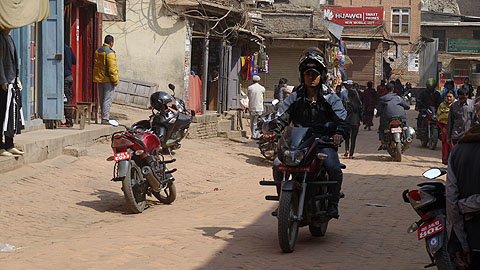

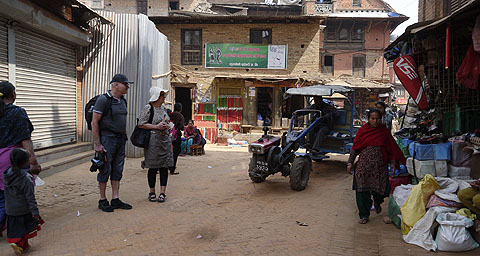

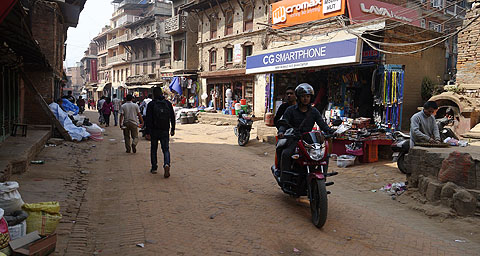

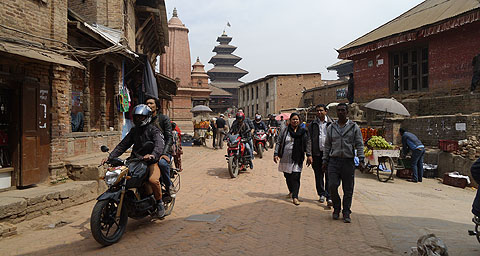

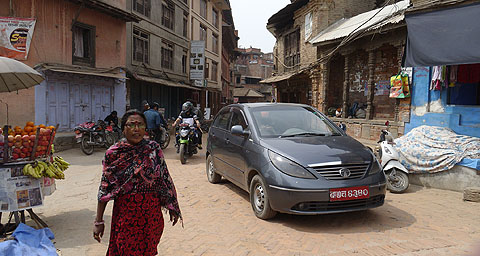

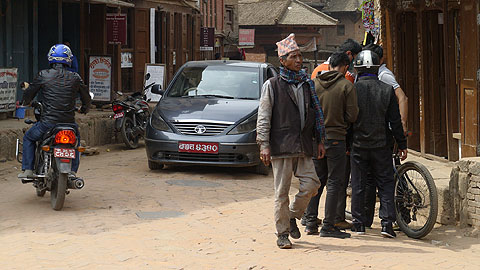

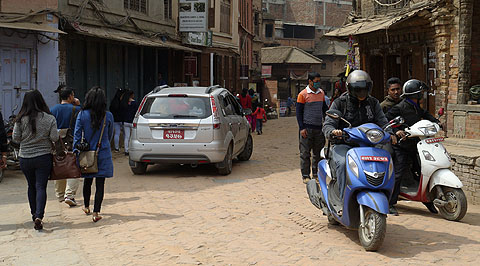

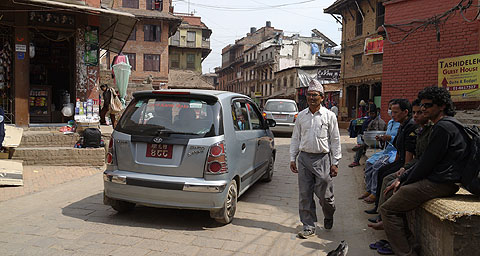

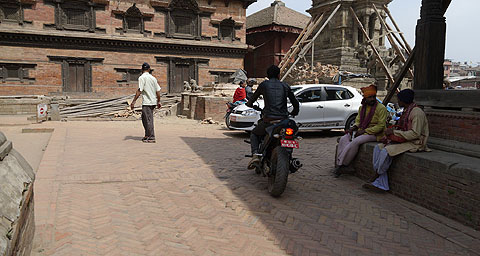

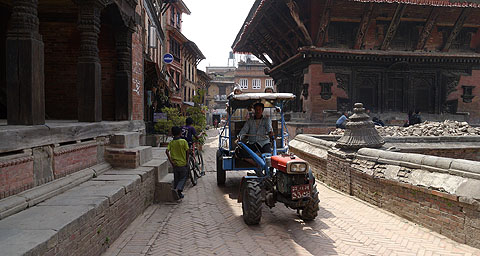

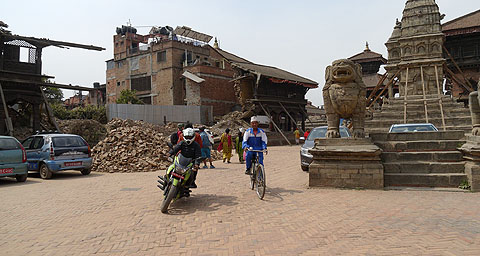

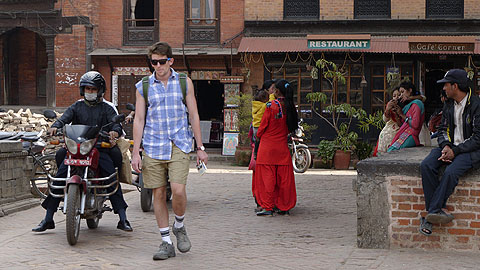

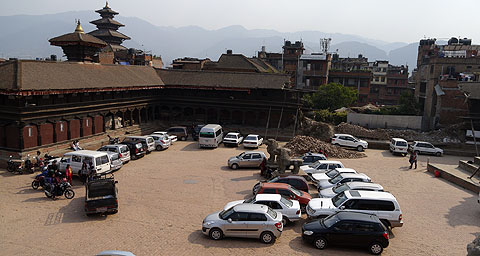

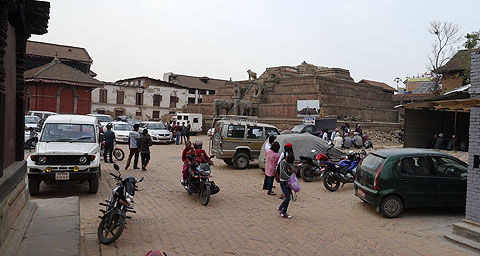

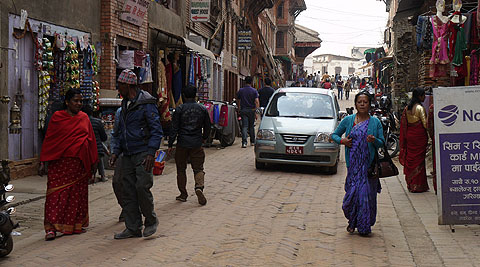

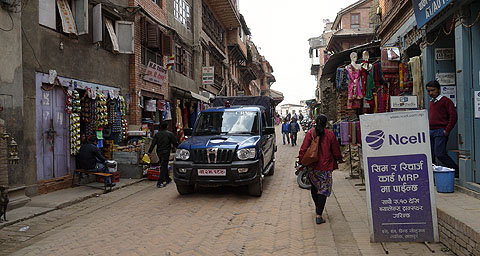

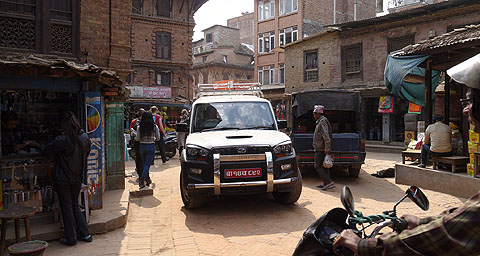

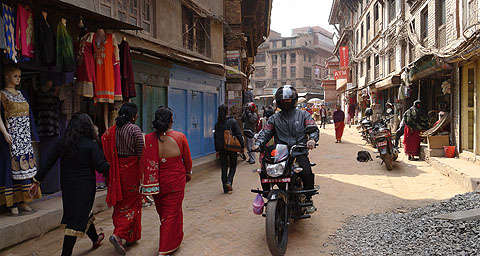

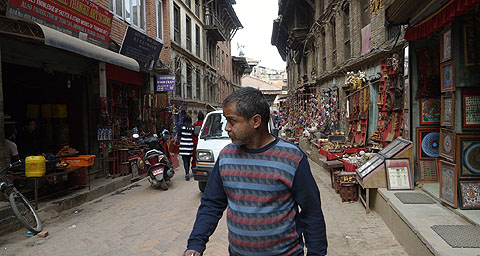

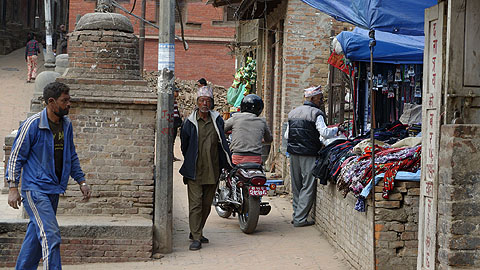

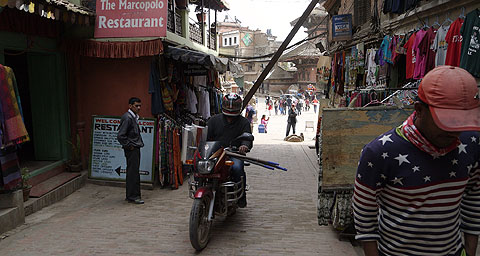

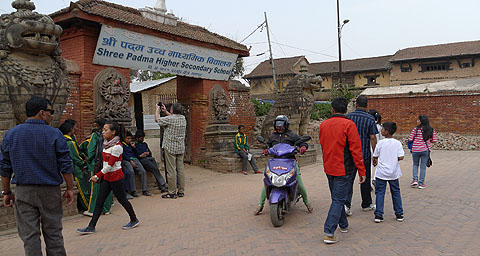

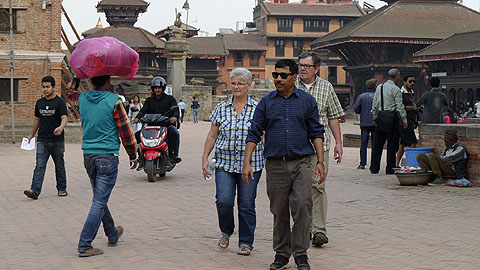

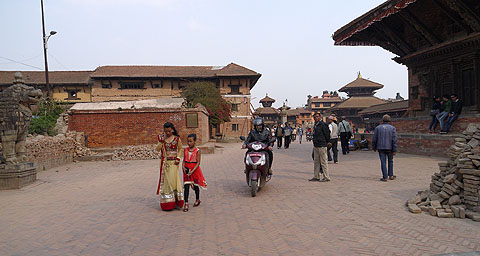

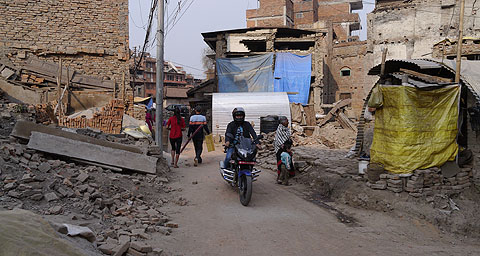

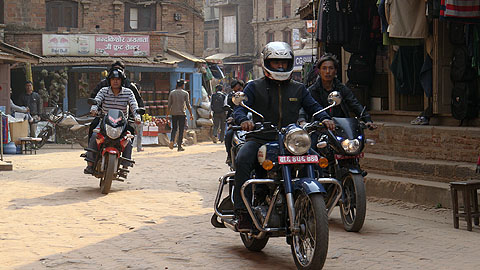

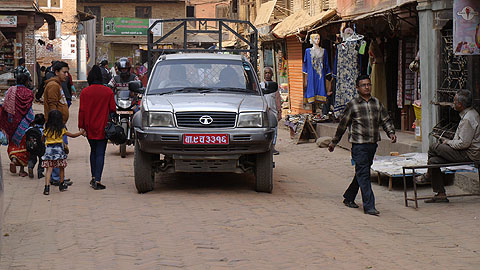

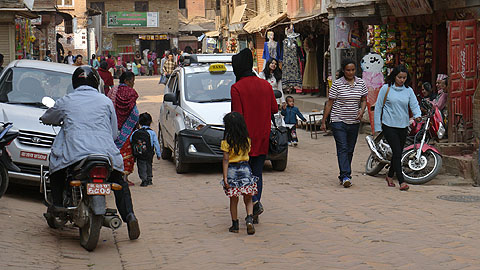

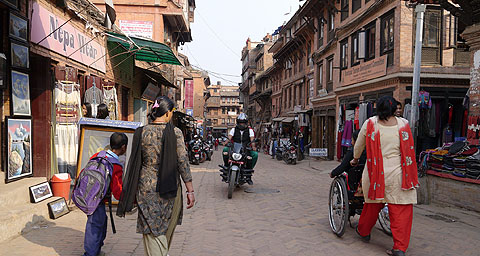

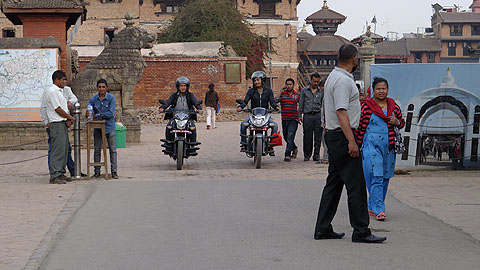

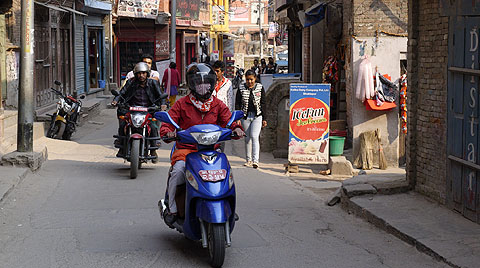

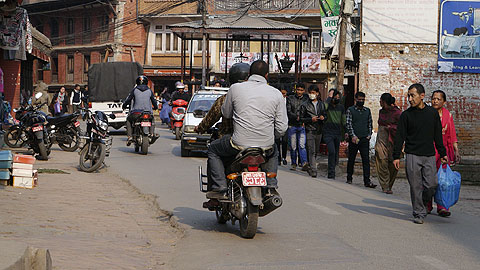

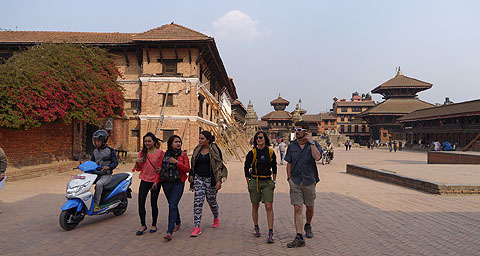

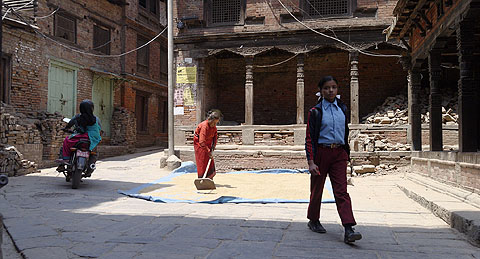

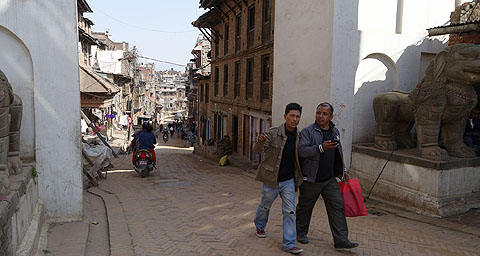

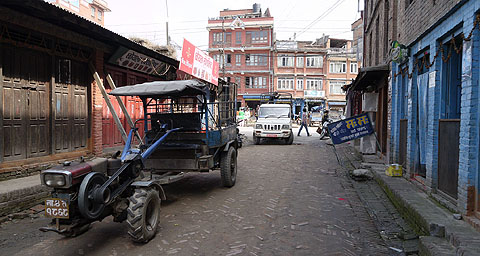

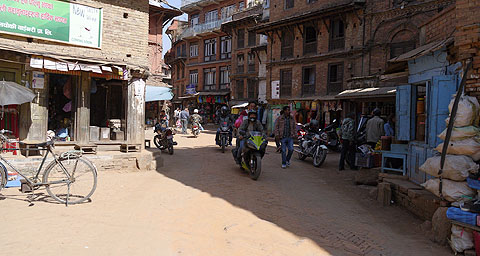

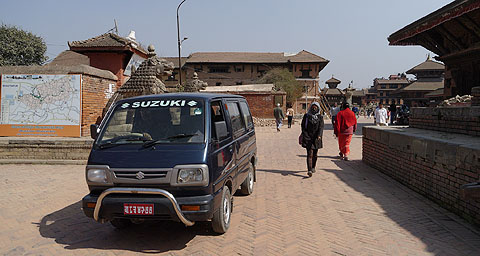

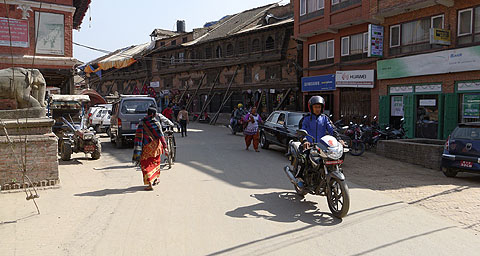

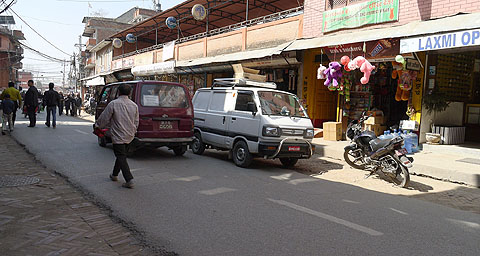

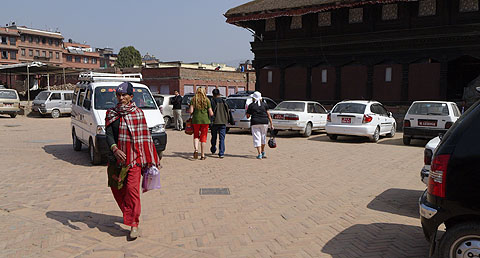

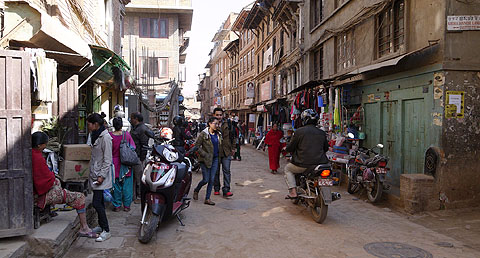

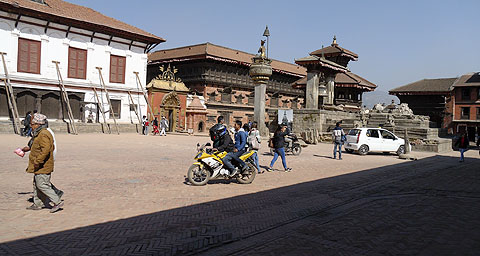

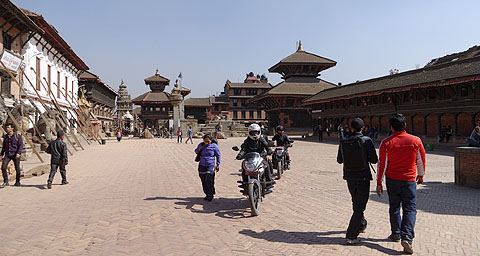

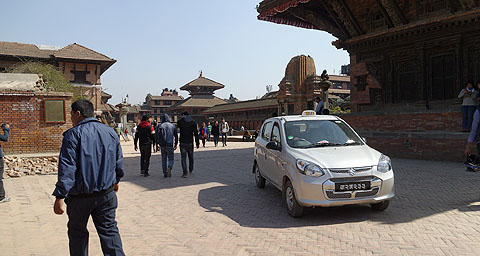

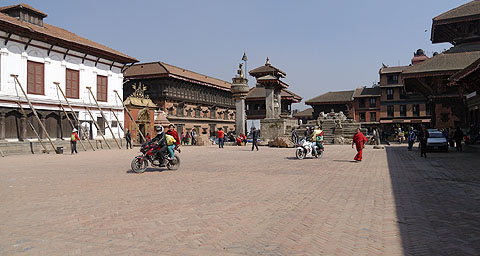

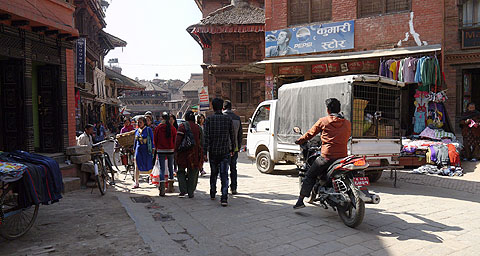

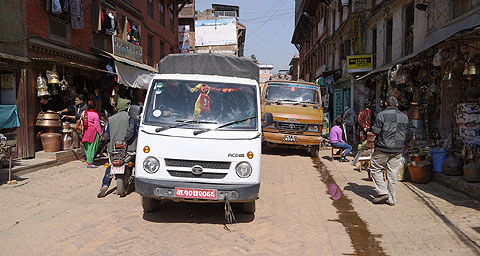

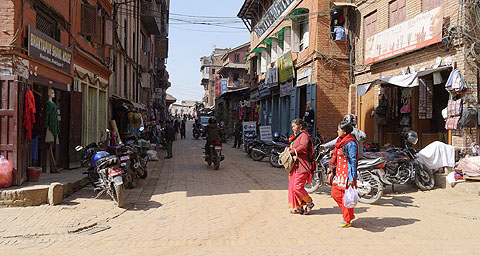

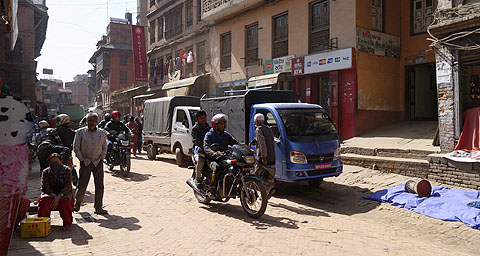

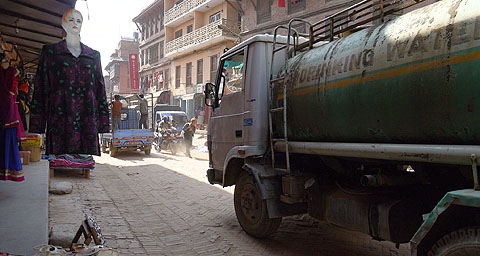

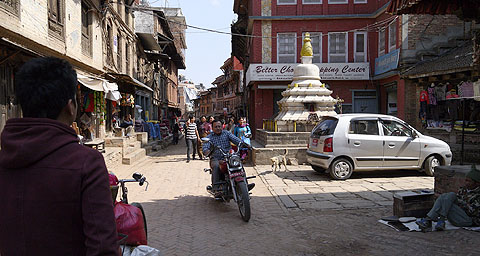

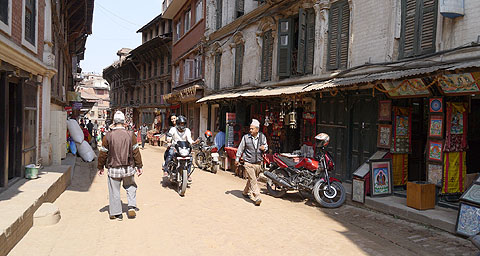

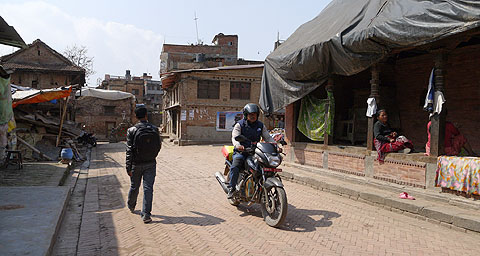


|

|

Announcements
The Books
Carfree Cities and Carfree Design Manual are widely available from booksellers in Europe and North America.

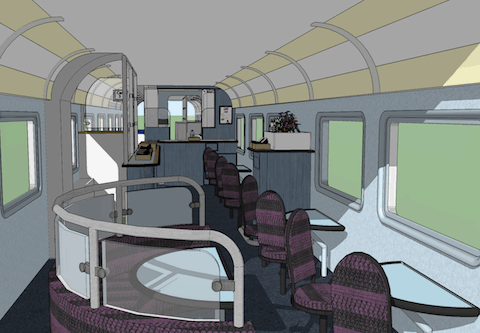
Amtrak Café Car

©2017 Andy Likuski
The Amtrak Standard
By Andy Likuski
Here's something you don't hear everyday:
"Let's design our public transit
to the Amtrak standard."
Before you retort with a quip about Amtrak, I'd ask that you contemplate the feeling of sitting in Amtrak's plush seats, perhaps beside your traveling partner, maybe even across a table from your scenery-entranced children, or better still those pleasant journeys when you shelled out for a sleeping car or, failing that, you realize you're going to keep two seats to yourself for the whole trip.
Now consider that as your ride is gliding smoothly and nearly silently down a railroad free of cross-traffic, ugly billboards, and strip malls, you have the option of getting up at any time and walking to the relief of a large restroom or to a staffed café car for a coffee, beer, or snack. You can ask the most mundane or arcane travel question to the staff and they will try to help you. Such possibilities don't exist in a car, bus, or plane, and they aren't offered on other forms of urban railroads, namely metro (subway), light-rail, or streetcar. You couldn't even be as comfortable in a car or plane unless you pay for something extravagant like a private tour bus or a business-class ticket on Emirates Airlines.
Amtrak is rightly critiqued for its mediocre travel speeds, schedules, the limited reach of its network, dated equipment, and most of all for the infuriating lack of reliability and safety technology on all of those tracks that it does not own. But the comfort of riding on Amtrak when everything is running optimally is frankly excellent, better in comfort than coach class of some of the European and perhaps Asian passenger trains to which we so aspire. This is especially true of the newer double-decker Amtrak trains west of the Mississippi versus the older East Coast trains (Acela being the expensive East Coast exception).
Throughout the history of public transit, we've assumed that metro, trams (I'll use this European catchall for light-rail and streetcars (a.k.a trolleys)), and buses cannot offer the same level of comfort as a regional train. But worse than that, we have come to accept the idea that urban transit cannot be as comfortable as a private car, despite all the latter's comfort failings. More consequently still, decision-makers and the media typically deprioritize the user experience of transit while obsessing about capital and operations costs, leading to the perverse goal of trying to pack as many passengers as possible into as few vehicles as possible without losing too many discretionary riders to driving. Where they do pay attention to user-experience, it is largely focused on safety and legal mandates, the result being negative outcomes like glaring interior lights at night to deter crime, rules of behavior plastered all over the vehicles with no actual enforcement, and mediocre compliance with ADA (Americans with Disabilities Act) laws within the cramped interior of a bus (ADA compliance makes for a better experience for everyone, but only when vehicle size is large enough, as I'll discuss later.)
The obsession about cost efficiency, safety, and accessibility would be excellent standards for public transit user-experience if they weren't our only standards. Because we neglect the rest of the user-experience, our systems are designed for the lowest common denominators, making the ride for everyone somewhere between mildly uncomfortable and miserable.
What would it mean to design all public transit to the Amtrak standard in terms of the user-experience of riding in vehicles and accessing them at Amtrak's best train stations? Let's look at some major aspects of user-experience and how they might be applied to metros, trams, and buses and their access areas. Afterward we'll discuss how to implement and pay for these improvements, as well as how to maintain and upgrade them over time.
Smoothness and Comfort of Travel
To experience maximum smoothness we must travel in fixed-guideway vehicles. Fixed-guideway most often means vehicles that run on steel tracks with steel wheels or cement tracks with fixed rubber tires (rubber tires are occasionally used for metro systems and frequently for people movers at airports and for monorails). Less common fixed-guideway vehicles are gondolas (aerial trams), funiculars (ground tracks on steep hills), and magnetic levitation (mag-lev) trains. A bus that travels in its own lane has dedicated right-of-way (ROW) but is not fixed-guideway (although it is inaccurately called fixed-guideway in the USA.). Such buses are typically branded as bus rapid transit (BRT), based upon a brilliant innovation in Curitiba, Brazil, in the 1970s when the city couldn't afford rail. Trolleybuses (those with overhead wires for power) are also not quite fixed-guideway, since their power source is fixed but not the tires. I regularly ride in both fixed-guideway vehicles and buses, and a bus typically feels to me like sitting in the bed of an old pickup truck, whereas fixed guideway gives me a unique sensation of sliding along. How would you describe each one?
BRT buses (and others) can run somewhat smoother if the pavement is kept in excellent condition, and if they use electric motors. However today's low-floor buses, which are designed for limited mobility boarding, are extremely sensitive to pavement irregularities. Articulated buses (with those accordion connected segments) can furthermore suffer from vertical pivoting at the articulation points. I generally find that even the sixty-plus-year-old trams in San Francisco and New Orleans feel smoother than modern city buses. Smoothness really matters; it is one of the disadvantages of BRT (and airplanes!) to user-experience that receives no acknowledgement from BRT advocates.
In addition to smoothness, comfort is greatly impacted by the number of changes of acceleration (change in acceleration is appropriately called jerk), and especially from those changes that are unexpected. Manually driven buses and trams are subject to irregular acceleration by drivers, which decreases the comfort of travel by jerking riders. When trams and buses lack their own dedicated ROW, the result is frequent, intense jerks for both modes plus frequent lane changes and pull-outs by buses.
Types of Right-of-Way
The key to smooth and comfortable travel is giving vehicles Class A or B Right-of-way (ROW). Class A ROW means that lanes are dedicated to the transit vehicle and any intersections with streets are grade-separated (elevated above or submerged below the street level) or fully protected by crossing signals. Metros and regional trains always have Class A ROW - they are never blocked by cross-traffic aside from trains on the same railway. Class B ROW is similar to A but without complete priority at intersections - transit vehicles might have to wait at red lights while cars cross.
Trams and BRT buses should always have at least Class B ROW, which can approximate Class A ROW in terms of lack of stops if the transit vehicle has signal priority - meaning the ability to change its traffic signal to green as it approaches. The lowly Class C ROW means that transit vehicles operate in mixed traffic (no dedicated right-of-way). Class C ROW vehicles are a lost cause in terms of comfort (not to mention predictability) since they will inevitably make unexpected stops when their lane is shared by cars, bikes, and other users of the road. Class C ROW should be reserved for low-ridership bus lines where no congestion ever occurs.
Sadly, many new tram systems in the USA have been recently constructed with some or all Class C ROW (the systems in question are the smaller streetcars rather than the more heavy-duty light-rail). Such planning compromises have recently occurred in Portland, OR, Seattle, Cincinnati, Washington DC, and are planned for Los Angeles among others. Boston and Toronto perpetuate this planning error on some of their old lines. In terms of buses, BRT by definition should have Class B ROW, but in the USA it has almost always been compromised to a mix of Class B and C right-of-way, with the somewhat reasonable psychology that full Class B right-of-way is too valuable to dedicate to a bus.
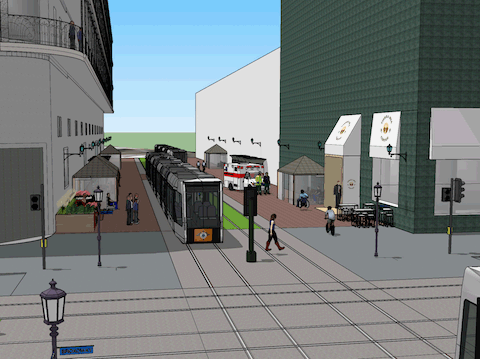
Station and Stop Amenities

©2017 Andy Likuski
Frequency of Transit Stops
The other enemy of smooth, continuous travel is the placement of designated stops or stations too close together. This is most common for buses but also occurs with many old and new trams in America. The frequency of stops is not just an unpleasant physical sensation but also fuels the mental angst of inefficient movement and wasted time. Another huge time-waster is passengers lining up to pay the driver of a bus or tram. It is ridiculous that any transit vehicle in modern times should make riders enter through only one door and then allow them to waste time counting out change. Proof-of-payment combined with choosing between online or on-board fare machine purchase (placed in the middle of each rail car or bus) are now trivial to implement and accessible to all income levels.
Let's contemplate some rough numbers about travel time. A regional train rider might comfortably stop every 5 to 30 minutes, depending on population density of the region. For me, stopping:
every 5 minutes for a 30-minute ride feels comfortable
whereas
every 5 minutes for a 3-hour ride is not
rather
every 20 minutes for 3 hours would be.
Since metros, trams, and buses have shorter average travel times, the number of stops is more critical. Stopping:
every 2 minutes for a 15-minute ride is easily tolerable
but
every 2 minutes for a 30-minute ride is not
rather
every 5 minutes for 30 minutes is.
The magic feel-good number on any transit is probably about 5 to 8 stops for an average trip. Keep in mind that this only includes scheduled stops and assumes that no other stops occur due to lack of right-of-way or unexpected obstacles. Put another way, trams and buses should average at least 15-20 mph (25-32 km/h) including 10-20 second stops (dwell time) and stops at least 0.5 miles (0.8 km) apart, thus stopping once within every 90-120 second window in the densest urban areas, and further apart as population dwindles.
Another good rule of thumb is that trams and buses should always be at least as fast as a moderate cyclist traveling on a flat road without interruption, or similarly at least as fast as a car that is stopping regularly at intersections. As a cyclist I like to ride when I'm in the mood, but I shouldn't suffer any time hit for throwing my bike on the tram at night or in bad weather.
For existing transit lines that stop too often for average trips but cannot remove stops, the only solutions are: 1) Run skip-stop service where odd trains stop at every odd minor stop and always stop at major stops, and even trains stop at every even minor stop and always stop at major stops. Both odd and even trains travel the same speed. 2) Build two more sets of tracks/lanes for express vehicles. Either option is more reasonable than it might sound. Various skip-stop strategies are typical of regional trains and work fine if we use excellent user interfaces to mark what stops are served by a vehicle. Adding passing tracks/lanes is an excellent investment if the two existing tracks/lanes are at capacity.
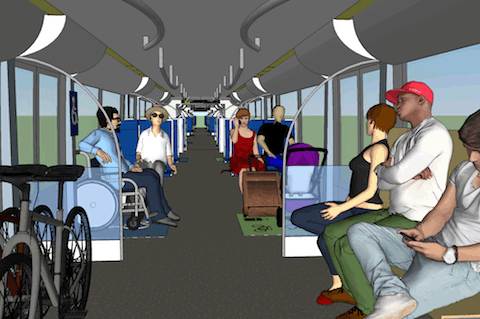
Metro Transporting Both People and Their Belongings

©2017 Andy Likuski
Space and Seat Comfort
Like Amtrak, transit vehicles should never be standing-room-only and should generally have several open spots per car to choose from. This includes during commute hours! Standing-room-only is acceptable only in exceptional situations like very bad weather, major events (e.g., a sports stadium emptying), or minor emergencies (e.g., a bridge closure that paralyzes car traffic). We should declare crush-load situations a catastrophic failure except in the case of major emergencies (e.g. a hurricane or earthquake). We expect the equivalent discomfort in a private car during these times (e.g. being stuck in traffic for hours or giving strangers a lift to help get everyone out of town). Avoiding standing-room-only conditions is vital because it keeps center aisles clear for the movement of passengers and thus reduces claustrophobia and anxiety about reaching an exit. It also makes it far more efficient for officials to check tickets and enforce good behavior, both of which I'll discuss at length later.
Comfort of Seating
Assuming a predilection for sitting while traveling (some people like me prefer to stand after a long day of sitting at work), what would the seating conditions be? First and foremost, we all want easy access to an open seat without searching or asking for permission to get around someone. This means that we all instinctively glance around expectantly for two empty seats forming a row or a single empty seat if single-seat rows exist. Failing that we'll acquiesce to an open aisle seat next to a well-behaved stranger. If you think about it, sitting down next to somebody on an airplane or train isn't quite as nice as an empty row to yourself (unless it's a party environment), but it's fine as long as the person is well groomed and keeps to themselves when you want them to. Most of us like plush seats if they can be guaranteed to be reasonably clean, perhaps as clean as a train or airplane seat. Classy wooden seats are occasionally okay, especially on historical vehicles (like the St. Charles streetcar in New Orleans) or novelly located in designated parts of new vehicles, like the end sections of Munich's new U-Bahn cars. Plastic seats, metal seats, or seats with unpadded fabric are the worst seating in terms of comfort, save for a backless bench (which I've never experienced outside of open-air sightseeing train cars).
Situation and Orientation of Seating
Other important characteristics of seats are their situations and orientation. The height above the ground matters (e.g. small luggage should fit under seats), as do the height of backrests, the amount of legroom, the orientation of the seats (forwards, backwards, or sideways), presence or lack of armrests between seats, the possibility of reclining a seat, and the presence of protrusions from the floor, such as bus wheel-wells. Another common problem is the presence of wind blocks, small barriers perpendicular to the doors, as well as seats that are configured at a right-angle to one another so the side of one seat invades the legroom of another. Seat qualities like armrests and reclining seats may seem like a ridiculous luxury for metros, trams, and city buses (they are common on long distance buses), but the truth is that we have these luxuries when we drive just five minutes in a car, so why shouldn't we at least consider them for transit trips that are less than an hour?
Seat Comfort on Amtrak
Again, let's look at the Amtrak standard and passenger trains in general to discover the ideals. Passenger rail only uses sideways seats in observation cars where users want to look straight out the window. Inward facing seats are almost unheard of, except perhaps plush corner seats of old parlor cars. Many people like inward facing seats on metro because you never have to climb over a neighbor to reach one. Generally speaking, if vehicles are not overcrowded, meaning nobody is standing involuntarily and there are many empty rows of seats to choose from, then forward-facing seats (plush with plenty of legroom) are probably the ideal. I'll cede to anyone who prefers the inward facing seats of metros, but I think it's largely because they work better in crowded trains. Backwards seats are often used for bidirectional train cars or for seats grouped in four (which should always have a table between them).
Seat Crowding and Other Nuisances
The use of backward seats in buses to squeeze in more seats is problematic. Modern low-floor buses must have giant wheel well protrusions that encourage backwards facing seats to cover more of the wheel well. Such seats are nauseating and make it very difficult for us to see when our stop is approaching. Whenever rear-facing, I have to stare at my iPhone's GPS location on the map so I know when to get off.
Much of seat design centers on maximizing the number of seats, maximizing standing room for crowded vehicles, and maximizing the design to withstand wear-and-tear and be easily cleanable. It's okay to make durable seats if comfort is not compromised. The quantity and layout of the seats should put comfort first, with the understanding that the solution to crowded transit vehicles can only be major increases in vehicle length, frequency, and in new lines.
Another area of consideration for seating is the proximity to nuisances, for instance:
- Loud and/or cold air that is blown through the ventilation system
- Harsh lighting at night, most recently LED lights without appropriate softening
- Motors - especially of diesel buses but also diesel-multiple-unit (DMU) trains and even the high pitch of electric motors
- Doors of trains that frequently open and close, exposing passengers to uncomfortable noises and variations in temperature - there should be plenty of seats far away from the doors
- Exposure to loud or repetitive loudspeaker announcements or broken loudspeakers
Such nuisances can easily be minimized if user-experience is considered holistically.
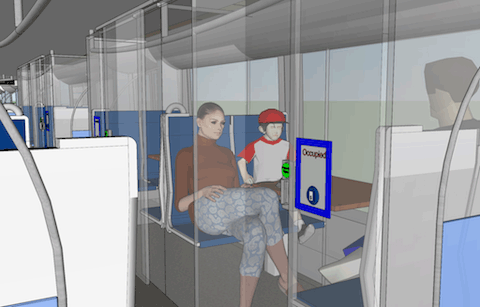
Personal Space and Privacy

©2017 Andy Likuski
Personal Space and Privacy
Privacy on transit vehicles might seem like a non-starter. But if we can enforce good behavior on transit, which we must begin to do, then some privacy is possible. Long-distance Amtrak trains typically offer sleeper cars, which are a sensible and delightful luxury on long trips. Sleepers give passengers the ability to lie horizontally overnight and to sit during the day in an enclosed space alone with their travel companion or even the whole family. Private automobiles offer a similar level of privacy but without the ability to escape the confined space. European trains historically offered private or shared compartments for the upper classes and later to all classes. These compartment trains are disappearing in favor of North American-style row seating, but there are at times advantages to choosing a quiet room with four or six strangers rather than a loud car with a hundred people.
Should regional trains, metros, trams, and buses offer private space for an extra fee? Let's first assume that such private space could be seamlessly purchased on board with a smartphone or reserved online, and that the technology would allow passengers to unlock a compartment. Such a feature would require the level of good behavior that is expected on long distance Amtrak trains. People wouldn't try to invade your paid-for compartment, nor would inappropriate activity be tolerated in compartments (drugs, loud music, sex, etc.) There would likely be no visual privacy, just a glass door, which would prevent most bad behavior. In which vehicles, if any, would this work? Certainly regional trains could offer paid compartments. The compartments barely take more room than row seating if they were configured as four seats that you could reserve in part or full. But more expensive one- or two-seat compartments for business travelers might also be practical. How about on metro? Do private compartments make any sense for a ride that's less than an hour? Maybe, if the reason to rent it is to get some table room to conduct business or a quiet space to take a nap after work. On trams and buses the answer is almost certainly no, but other private amenities like restrooms might make sense there. Let's discuss that next.
Access to Amenities
Toilets and café cars are wonderful amenities on Amtrak and some commuter trains. Long-distance Amtrak trains also have sleeping compartments, dining cars, showers, dressing rooms, sight-seeing cars, parlor cars, spaces with toys for kids to play, and even movie rooms. We should treasure these features of long-distance train travel; they are perhaps the highest order of public transportation comfort alongside cruise ships or overnight ferries.
Toilets
Let's begin with toilets because they satisfy such a fundamental need. Most regional trains have toilets, as do some long-distance buses, although the toilets of the buses often come at the expense of the unlucky passengers having to sit next to them. Metros and trams almost never have toilets, which is a shame. The one exception I have experienced are the tram-trains in the Karlsruhe region of Germany. Tram-trains function both as regional trains and trams by switching from regional track to tram track when they get into the city. The dual mode means that even when functioning as trams, the toilets are fully available, a remarkable convenience. Again assuming the enforcement of good behavior, it seems reasonable to allocate space on metros and trams for restrooms. Restrooms on trains generally work very well. I've rarely encountered a messy restroom on a train unless the toilet or sink were backed up.
If we can have good behavior on transit we should be able to support restrooms. One noteworthy challenge for metro cars is that the operations team prefers that all cars be identical in configuration, which would mean a restroom in every car. I think a compromise that puts a restroom in every other car and assumes a pretty even distribution of cars would be acceptable. If the cars are high-tech enough to signal where the closest restroom is, people won't mind walking a couple cars. Again, this assumes that normal conditions on the metro are no standing-only passengers who block the aisles. For some time European metro systems (and now a few North American ones) have been deploying trains with no doors between cars, creating a single long corridor (called open gangways). This layout would make finding a restroom much easier. Modern European trams are similarly an open gangway of attached units without doors, so one restroom at the ends or middle of the tram would work well.
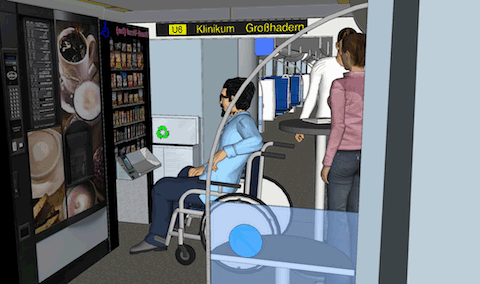
Access to Amenities

©2017 Andy Likuski
Cafés
A similar case can be made for café sections on metros and trams, but probably not buses due to the space constraints and the dangerous bumpiness walking around with a hot beverage. Even trains are shaky enough to recommend lids. Café sections could be as simple as a vending machine or two and some bar style tables for passengers to stand around. All beverages on a metro or smaller transit vehicle would have to come with a sealed lid to prevent major spills. Once again, assume good behavior: children are supervised by parents, adults by staff and other riders, allowing metro and tram operators to permit sealed beverages. Snack food could similarly be sold from machines, especially things that aren't messy (e.g. cold sandwiches but not popcorn or Cheetos). But why, might you ask, do we need food and drinks on transit? For the same reason we do in a car or when we're walking down the street. We get hungry, thirsty, and/or want a little diversion and/or chance for social interaction. These yearnings are something that can perk up an otherwise routine trip. We should consider it a viable option on transit, whether or not the food is revenue positive or negative. One of my favorite parts of getting on Amtrak is knowing I can go get a coffee, beer, or burrito whenever I want. That represents economic value in itself; it makes me ride more often.
Expectation of Good Behavior
Much of the better user-experience I've outlined here relies on the enforcement of good behavior on transit. Some of the bad behavior I routinely endure on transit is panhandling, disorderly conduct, playing music out loud, and making a mess with food. And more serious offenses certainly occur. We should insist that everyone behave as well as passengers do on a plane or Amtrak train, where bad behavior succumbs to the chiding of a chipper flight attendant or wrath of a surly conductor. Both flight attendants and Amtrak conductors do a very reasonable job of enforcing good behavior, to the point where bad behavior is surprising. I do experience worse behavior on Amtrak than airplanes, but it's mainly something benign like kids listening to music out loud on their phones. I can get myself worked up enough to tell them to turn their music off because I know it's bothering everyone else, and I have the conductor to back me up if there's any problem. I would never intervene on the metro, tram, or bus for fear of getting assaulted, but also because bad behavior is so widespread on those modes that it's not worth the fight.
Why is bad behavior widespread on transit, aside from regional trains, and how can we quickly fix it? Behavior is in part worse because there are far more passengers and a greater socio-economic range of them getting on and off in crowded conditions, but the real problem is that there are no conductors on board to enforce good behavior. Think about how crazy it is to have hundreds or thousands of people on metro cars and platforms without the frequent presence of officials. Is the answer then that we have conductors on metro, trams, and buses? Yes, sort of. What we should have is what proof-of-payment systems ideally do. They have officials appear frequently but unpredictably on vehicles to check for proof of payment, which they can do speedily with modern technology. These officials are wandering the aisles anyway, so they should also be well-paid to enforce good behavior. They already have the power to warn or fine for fare violations; they could additionally do so for breaking behavior rules. The point isn't to make money from fines, it's to maximize good behavior. For fare-paying riders, the presence of friendly but strict officials is generally welcome, as long as those officials are representative of the population, do their jobs well, and don't discriminate.
Improving Behavior and Convenience
Now, if metro systems have faregates, how can they justify having officials checking payment and enforcing good behavior on board? Germany already has this figured out. Get rid of the faregates! Faregates are an archaic vestige of the days when the only way to pay for the metro was with paper tickets or tokens. Even modern faregates that open by tapping a radio-frequency identification (RFID) card or smartphone are an enormous inconvenience to paying customers. They bottleneck traffic in and out of metro stations. It's true that they prevent some fare evasion, but at what cost? The maintenance of mechanical equipment, its replacement when new technology comes online, and the wasted time and space is all extremely expensive, all in the name of inconveniencing the 95-plus% of people who gladly pay their fare, or at least would if they knew there was a good chance of being fined on board for fare evasion.
Faregates are also the minority means of paying to use transit. Regional trains and trams generally rely on proof-of-payment, and more and more buses have technology enabling rear-door boarding with card and smartphone scanners. Metro has traditionally used faregates because of the relatively low number of stations, which happen to already be constrained by being underground or elevated above ground. But station design suffers tremendously from faregates by forcing entire levels just for processing tickets. Imagine if users could take stairs or escalators straight to the platform level with no silly faregate bottlenecks! It would vastly improve station design by eliminating the segregated paid and unpaid areas. Elimination of faregates also frees up station agents to leave their adjacent “guard towers” and roam the station to assist passengers and enforce good behavior.
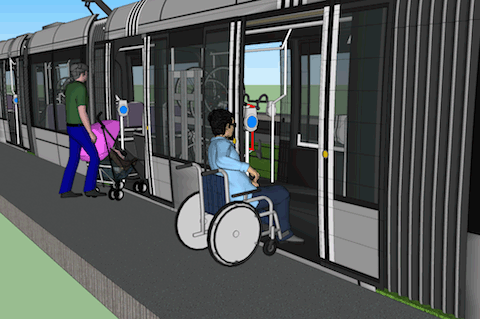
Personal Transportation and Freight Accessibility

©2017 Andy Likuski
Active Transportation and Freight
Bikes, wheelchairs, luggage, and packages all need to be accommodated on transit in order to give all potential users an excellent user-experience. Bikes are an essential part of the transportation system, and their small form factor and near ubiquitous ownership makes it reasonable for people to want to use the same bike on both ends of their transit trip. Bike share, folding bikes, and bike parking are great too, but not always as comfortable or convenient. Any regional train can be retrofitted or designed to carry large numbers of bikes in a special section. It might be acceptable (it is common on European trains) to charge people a little extra to bring their bike on board, as long as the fee acknowledges that bikes pack tightly together and decrease the cost of providing feeder transit services. My guess is that the reduced cost of feeder service and parking amenities is more than enough to warrant free bike boardings.
Metro similarly has plenty of space for bikes if the system is scaled up to eliminate the need for passengers to stand under everyday conditions. Each metro car can typically fit about ten bikes per car comfortably, which means up to a hundred bikes on a long train. Trams are long enough to have dedicated bike hangers, and many do, especially the larger North American light-rail vehicles.
By contrast many public and private buses offer rack space on the front or rear (namely university and corporate shuttles) of the bus, but they can never be relied upon to have an empty slot and are at risk of theft and damage. Some buses have a bit of indoor bike space if they are articulated, but generally buses and bikes are a bad match since bus interior space is limited.
Freight and luggage should get dedicated space via overhead shelves, under seats, or in special luggage racks on all modes of transit. Again this is hardest on a bus where space is constrained. Bikes and freight are one of the many reasons that trams rather than BRT should replace all major bus routes.
Wheelchair users should be able to board a transit vehicle just as easily as a person on foot. The vehicles must have level boarding for roll-up rides and not require seat belts to secure the chair. With nobody standing there is always plenty of room for one or two wheelchairs per door of rail vehicles. Again, buses are a bad match for wheelchairs. Buses have a higher floor than trams because of their larger wheels, and lack of fixed guideway means being flush to platform is impossible. Thus level boarding requires elevated platforms with mechanical bus ramps as well as driver-assisted seatbelts to secure wheelchairs. Modern trams can arrive with their entryways horizontally and vertically flush with a normal curb.
The removal of faregates and investment in plentiful elevators tremendously helps out bike and wheelchair users as well as those with luggage and other personal freight. Other amenities such as luggage/bike conveyors that run alongside staircases are inexpensive additions that improve user-experience.
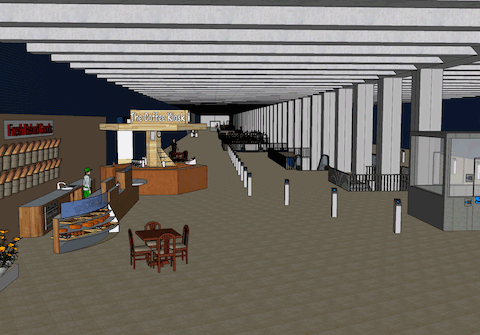
Station and Stop Amenities Inside

©2017 Andy Likuski
Station and Stop Amenities
The days of a dark, dank, metro platform and transit stops exposed to wind, rain, and grime must come to an end. The proper model for an indoor station is that of a hotel lobby. Large hotel lobbies have high throughputs of people coming out of the elements, yet they manage a comfortable and civil environment with comfortable furniture, good lighting, helpful staff, restrooms, shops, and near constant cleaning. Outdoor stops should likewise be modeled after pedestrianized streets and plazas (in Europe tram stops are often in pedestrian areas surrounded by amenities).
The first step to increasing quality, particularly for tram and bus stops, is to limit the number of stops to the spacings that I have suggested above so that more resources and attention can be dedicated to the major stops. By having aesthetically pleasing and comfortable stops at named centers throughout a city and region, neighborhoods form their identity in part by their transit stop. It's already true of train stations and some metro stations, where people and businesses specifically dwell near the station to benefit from and give benefit to it. Such development is also common around tram stops if the stops are strategically spaced to bring all comers and goers to a central meeting point for the neighborhood. A BRT stop might be able to simulate the feeling of an important stop if it can attract the level of passenger use and business situation that a fixed guideway transit stop does. I believe that BRT has not yet proven capable of this in North America, partially because there are no BRT systems in America built to the full standards developed in South America, but also because of the inferior user-experience of riding any bus and lack of permanence that only a fixed guideway can provide.
In terms of physical amenities, an indoor train, metro, or tram station (some light-rail stations in North America are indoors) should be treated as a small indoor shopping area for purchasing daily essentials and frequenting leisure businesses like cafés, restaurants, and bars. Major train stations and metro stations in Europe offer bakeries, produce markets, and pharmacies to convenience passengers. Any indoor station should have enough space for restrooms. Europe often provides pay restrooms with turnstiles or human custodians, which is reasonable in exchange for clean restrooms if you can easily make change for 50¢ or pay with technology. Whether free or paid, obvious requirements for restrooms are that they be abundant, clean, and safe. I see no reason why self-cleaning sidewalk restrooms shouldn't be at every outdoor tram or BRT stop unless the vehicles themselves provide restrooms. There is nothing less dignified than being denied a toilet or sink when in need while using transit (or while driving or flying for that matter). Where such neglect occurs, the result is often urine-soaked stairwells and sidewalks.
Other major amenities, such as comfortable seating, good lighting, and protection from weather are as much about dignity as comfort. Riding transit should be considered a classy lifestyle, as much so as getting in a nice car, plane, or train is. This means that any stop or station should receive high quality upkeep just as a plane or train does. Again, we don't have to upkeep thousands of bus stops throughout a city. Instead we need to consolidate those to major stops and upgrade bus stops to tram stops so that they serve more passengers and thus justify their amenities. By having only major stops, it can become the job of a neighborhood business association or even paid local residents to upkeep their stop, which adds to the sense of community identity.
One gotcha of stop consolidation is caring for people with limited mobility who rely on stops near their home. My answer to this challenge is to humbly suggest that level-boarding vehicles and improved streetscapes make the overall experience better for those in wheelchairs and impaired walkers even if they had to make it a couple extra blocks to reach a major stop. Another possibility would be to have disabled-only stops. Such stops would be minor stops that could be requested by pushing a handicap stop request button in the area of the tram reserved for such travelers. Similarly trams would only pick up such travelers at the front door for minor stops. This idea has some major flaws, namely adding otherwise unscheduled stops. The alternative is to provide paratransit to all those who cannot reach major stops, which is a messy but perhaps necessary solution that is already in wide use. What we must stop doing is spacing stops too close together, negatively impacting the majority of riders and weakening the amenities of major stops.
Funding High Quality Transit
The only practical way to fund a vastly improved user experience on transit is to increase the costs of driving and direct the resultant enormous income to transit infrastructure and operation. Car use receives monstrosities of both explicit and implicit subsidies and causes incomparable social, economic, environmental, and health externalities. Driving must be reduced in most urban areas by at least 90% or further curtailed in large cities of the First and Third World where it is already not the dominant mode of transportation (e.g. New York and Bogota). It follows that public transit that is attractive to 90% of the population, in conjunction with large increases in active transportation (walking and cycling), is the only scalable substitute for driving.
Those who believe that transit should pay for itself through usage fees or subsist by current funding mechanisms are dooming transit to low mode share, dilapidation, and increasing catastrophic failures. Without significant revenue from the most wasteful and destructive activity on earth - driving and riding in private vehicles in urban areas - we are sending the message to users of sustainable modes of transportation that their choice cannot be as comfortable or even as safe as driving, even though all such modes are potentially more comfortable, safe, and cheaper than driving.
A Note About Autonomous Cars
Those who believe that autonomous cars remove the need for transit have the argument backward. Autonomous cars are an excellent technological development that might reduce the number of physical cars needed by an order of 90% in urban areas by replacing all private car use with an efficient taxi fleet. It means that most users will pay explicitly for each minute or mile of travel (just like with Uber/Lyft or Car2Go), which incentivizes them to prefer alternative, cheaper modes or at least have the car deliver them to a transit stop. Privately owned cars have a large sunk cost, so there is little incentive not to use them. Furthermore, you can't yet abandon one at your destination and pick up another somewhere else. Given per-mile or per-minute costs, it won't make sense for thousands of autonomous cars to transport people on freeways or major roads for long distances, especially since environmental externalities of freeways and driving will increasingly be accounted for by laws. It does make sense to replace center freeway lanes (one or more per direction) with fixed guideway transit and to use autonomous cars to and from the transit stop in low density areas. Autonomous cars should eliminate most car trips and incentivize massive increases in transit and bike use. That makes it all the more essential to improve the user-experience of transit to welcome riders who are transitioning from car dependency to occasional autonomous car use.
A Simple Funding Concept
There is a politically reasonable way to increase car-usage fees in order to fund high-quality transit. It begins with charging for car ownership and usage in order to fund specific transit that removes the need for cars in a specific corridor. For instance, a practical high priority transit improvement is to replace a bus that operates in mixed traffic on a four-lane road with a tram that receives exclusive use of two of the four lanes and enjoys signal priority at intersections. There are dozens of such corridors in the San Francisco Bay Area where I live. A heavy use area, such as Geary Blvd or Van Ness Ave in San Francisco, might instead justify an underground metro or tram. Regardless, the transit corridor should be funded by those who own cars within a half mile (.8 km) or a mile (1.6 km) of the corridor and by those who currently drive on the corridor. A half mile (.8 km) radius would be appropriate for a tram since it means about a ten minute walk (or less) for anyone within the radius. A mile (1.6 km) or more radius would be appropriate for funding a metro or regional rail that can attract users from farther away by using bikes, trams, autonomous cars, or minor buses to reach it. As an extremely simple example, consider a potential ten mile (16 km) tram line that currently has:
1) 100,000 vehicles owned by residences within a half mile (0.8 km)
2) 50,000 of those vehicles plus another 50,000 external vehicles access jobs and stores daily on the corridor
3) 10,000 additional vehicles pass through the corridor without stopping
The (1) 100,000 residential vehicle owners pay a new $100 per registered vehicle per year (on top of existing registration and parking permit fees) for a total revenue of $10 million per year.
The (2) 100,000 vehicles accessing services on the corridor daily also pay on average $100 per year for parking surcharges (whether public or private parking), making another $10 million. The parking could be purchased as needed or as a year-long pass.
The final (3) 10,000 through-traffic users also pay $100 per year on average to pass through the fee area (by paying $1 for non-resident day-pass access using a tracking device) for a total of $1 million.
Thus a sufficient $21 million would be generated each year to build and maintain the ten mile tram line and the infrastructure improvements to accompany it, without even considering fare revenue and government funding. The financial hardship to the drivers is a pittance (at most $200/year for the combined vehicle ownership and parking surcharge), probably not even enough initially to significantly alter driving behavior. All of these fees would be increased yearly a bit beyond inflation to discourage car driving and ownership as the tram line and accompanying infrastructure became available and increasingly attractive to use, a double win for transit use.
Such financing schemes are simple and fair and need not be controversial if the people who use cars in a given corridor pay specifically for high-quality transit on that corridor. Arguably, the car users are also paying to decrease the congestion that they are causing (and suffering from), and thus all payments can be considered a corridor usage fee rather than a tax (this might matter for political and legal reasons). More transit-progressive cities and regions might be politically able to pool funds from the region to fund improvements throughout the region, but such funding severs the connection between the reward of abandoning a car and getting high quality transit in the place where one previously owned or used a car. In the likely case that autonomous cars eliminate most car ownership, a simple per-mile or per-minute surcharge should be placed on the cars using the corridor to maintain transit funding.
Policy Recommendations
The funding example above shows that simple, straightforward financing could provide plentiful revenue to support high quality transit. It does not in itself however incentivize transportation planners to provide riders with an excellent user-experience. User-experience is not just a financial challenge but a business and societal one as well. We need to start crafting legislation that stipulates the priorities of public transportation. Such legally-binding mandates would give the same priority to user-experience as it does to efficiency and safety.
The following policies could form the basis of legislation:
Preamble: Transit supported by cycling and walking, unlike transportation systems with any significant car use, improve environment, equity, economy, social life, public health, and the aesthetics of urban places. Achieving a 90% or greater non-auto mode share shall be considered meeting the requirements of this legislation. Such a percentage of mode-shift requires investment in high quality user-experience on transit to appeal to the vast majority of the population.
1) Expectation of safety onboard, at stations, and on common approaches to the transit. Safety is enabled by the frequent presence of friendly fare inspectors, conductors, and other officials. Good behavior by all users of the system is strictly enforced by the same officials, similar to the level that it is enforced on regional trains or airplanes.
2) Expectation of convenience in terms of frequent, time-efficient vehicles. This is accomplished by investment in a high-frequency schedule, even at off-peak times, and by eliminating all non-designated stops such as traffic lights and obstruction by car traffic. Additionally, stops are limited to neighborhood centers and important intersections so that average trips have a maximum of 5-8 stops, depending on the type of service.
3) Expectation of comfort approximating that of a regional train, or at least that of an airplane or private car. This is accomplished by almost always having a surplus of clean, comfortable seats and access to amenities such as restrooms, cafés, and private compartments that can be reasonably provided by the service type. It also means the ride is always smooth due to using a well-maintained fixed guideway and the highest quality vehicles available on the market. Similarly, stations and stops offer the level of comfort and amenities of the best existing train stations.
4) Capital improvements, operations, and maintenance, and supporting public space infrastructure funding is adequate to easily meet the above expectations. Funding is not borne by the users of the system; users are expected to minimally support the system with fares so that they pay directly for a service and thus expect excellent value from it. The goal of the system is to maximize the percent of overall trips that might otherwise be done with a car (and by a plane in the case of high-speed rail). Fares should be set to maximize usage and never revenue. The system shall therefore be funded to scale to comfortably support 90% mode-share between transit, bikes, and walking in urban areas, with occasional car use making up the other 10%. Fees for private car ownership, parking, driving, and taxi or autonomous car usage should provide 90% of transit funding, in order to remove the subsidies and externalities of cars and thus discourage them in favor of sustainable modes.
5) All revenues and expenditures are tightly scrutinized, but scrutinized with the goal of most effectively satisfying the aforementioned expectations. Funding is not scrutinized in order to minimize the level of service or maximize the occupancy load of vehicles. It is understood that a transit vehicle that is half to three-quarters full is the ideal, and mostly empty vehicles are preferable in terms of service quality to full vehicles with no available seating.
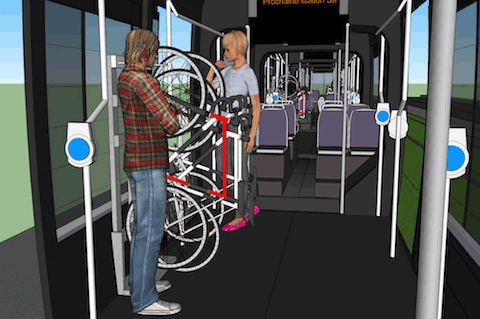
Personal Transportation and Freight Bikes

©2017 Andy Likuski
Conclusion
Right now in the USA and elsewhere, there is a scarcity culture about infrastructure and especially public space and transit. The result is petty fighting among advocates concerning one transit corridor versus another, misinvestments in lower user-experience modes like bus rapid transit, and little ability to recognize that substantial and increasing fees on car use is the only way to restore our public space to the civility and civic focus it once enjoyed.
The only solution, as I see it, is to change our thinking about what we want public transit and its accompanying amenities to be. We need to bring the best of American (or your country's) culture to transit, not the worst. In the case of American culture, this means friendly but orderly, it means a lot of comfort and a little luxury. It means plenty of free space and the chance to pay a little for privacy. It means good behavior that is enforced by officials along with (often loud) encouragement by the public. It means getting around quickly without having to wait, and fixing inefficiencies when they emerge. Americans also like fairness, and any sensible one of us can see that car use is unfair, whether in terms of allocation of public space or destroying the environment (and climate) in which others live. Let us use the money wasted on cars to achieve transit that has both abundance of service and abundance of excellent user-experience. They are both essential to the massive cultural appeal of transit, which we once possessed and must now regain.

First published November 1, 2016. View the original, interactive presentation.
Andy Likuski is an urban planner and software developer who uses technology to improve urban planning advocacy and outcomes. He is dedicated to improving transit, cycling, and public space by combining traditional planning methods with 3D visualizations, interactive maps, and geospatial analysis. He spent the previous four years leading software development of the land-use planning software UrbanFootprint at Calthorpe Analytics in Berkeley, California, and now works independently.
He can be reached at: andy@likuski.org

News Bits
The links below will open in a new browser window or tab, depending on your browser; (Ctrl+click) may behave differently:

Urban Planning and Design
"Ideas & Inspiration for Better Cities"
"Be inspired!" the web site says. That says it all. This is a wonderful source of before-and-after photographs of city areas that got fixed. (Urb-i.com)
"How Syria's architecture laid the foundation for brutal war" [video]
"What caused the war in Syria? Oppression, drought and religious differences all played key roles, but Marwa Al-Sabouni suggests another reason: architecture. She suggests that Syria's architecture divided its once tolerant and multicultural society into single-identity enclaves defined by class and religion. The country's future now depends on how it chooses to rebuild." There may be some crucial lessons to be learned from this. (TED.com)
"Placemaking for Peacemaking: A two-way approach for promoting inclusion and interaction in socially fragmented cities"
I'll say it one more time: social glue is what holds societies together. It is the responsibility of urban planners and designers to build into the city's fabric countless little places for the glue to develop. It is nearly impossible to do this if more than a handful of cars have to be accommodated. (SustainableCitiesCollective.com)
"The Uncanny Power of a City Without Cars"
"Europe's largest pedestrian-only urban space is also one of its most fragile. But Venice may hold lessons for other cities struggling to adapt to a changing world."
I was last in Venice in 2012 and was terribly upset by the general deterioration of the city's social environment. It really has become mostly just a tourist destination. And the roar of boats on the water has become nearly as unpleasant as the roar of cars on city streets. Seen from the air, Venice is now ringed by water-taxi wakes, a symptom of too many tourists with too much money. There's nothing wrong with the public ferries. (CityLab.com)
"X-Ray Your City's Street Network, With a Bit of Code"
"A city's street network is like its skeleton - a foundation for features like pipes, electrical lines, buildings, and public spaces. The angles at which pathways intersect, the shapes they wrap around, and how wide or narrow they are convey how the city has evolved, and whether it's designed to bring people together or fling communities apart. In that way, each city's very identity lies in its streets."
When it's done wrong, it's the hardest thing there is about a city (or suburb) to fix. Generally, the smaller the scale, the more people-friendly the network. (CityLab.com)
"America's Walking Renaissance" [Dropbox PDF download!]
This is a book-length work. The title says it all. Worth a look even if you think you already know this stuff. (America Walks via Dropbox.com)
"Paris mayor unveils plan to restrict traffic and pedestrianise city centre"
"Anne Hidalgo says she wants to cut the number of private cars in French capital by half as part of campaign to tackle pollution" (TheGuardian.com)
"Which is the greenest, happiest country in the world?"
It's interesting that this comes from the World Economic Forum. It's a look at which societies are doing the best by their people and how much impact they are having on the environment. Winner: Costa Rica. I just visited there a few weeks ago, and I'd agree that the quality of life in this small Central American nation is very good, and it appears that the environmental impact is indeed comparatively low. (WEForum.org)
"Barcelona's Car-Taming 'Superblocks' Meet Resistance"
No surprise about the resistance, but I expect superblocks will come in any case. The dislocations imposed by these kinds of changes are large, but the benefits are even greater. Barcelona is taking a clever approach to these changes, which don't outright prohibit car usage (in the beginning) but do make it less attractive. (CityLab.com)
"Madrid's Christmas Present to Itself: A Car Ban"
"Madrid just gave its citizens a present for the holidays [Christmas and New Year's]. The city closed the entire city center to most cars, turning the urban core into a de facto pedestrian zone.
"Starting last Friday at 5:00 PM and continuing for nine days, vehicles belonging to non-residents are banned from entering a zone covering Madrid's historic core as well as Gran Via, the blaring, multi-lane avenue that serves as the Spanish capital's main drag and as a major through-route for crosstown traffic."
Madrid is a generally delightful city (and provided the setting for the cover photograph of Carfree Design Manual). I wish I had had an opportunity to experience the city without cars.
(CityLab.com)
"Montreal's Car-Free Street Network Gets Bigger All the Time"
"Every year, Montreal transforms more of its streets into public spaces where people can rub shoulders with their neighbors without worrying about car traffic. Block by block, experiment by experiment, the city's pedestrian streets are growing." (StreetsBlog.org)

Transport, Pollution, etc.
"Clean energy will be a $50-trillion industry, but Trump policies mean the U.S. won't benefit"
Trump is setting the USA up for failure. Very bad. (ThinkProgress.org)
"Breathe less . . . or ban cars: cities have radically different responses to pollution"
"When thick smog recently hit, Londoners were advised to avoid exercise, while Parisians got free public transport. Which is the best solution?" Do you really need to ask? (TheGuardian.com)
"Smog refugees flee Chinese cities as 'airpocalypse' blights half a billion"
"Tens of thousands of 'smog refugees' have reportedly fled China's pollution-stricken north after the country was hit by its latest 'airpocalypse' forcing almost half a billion people to live under a blanket of toxic fumes." (TheGuardian.com)
"In China is de 'armoedige' fiets het antwoord op verkeersinfarcten [In China the 'shabby' bike is the answer to traffic congestion]"
Back to the future all over again. China's cities had a great arrangement 20 years ago when I was in Shanghai. One look behind the hotel told the whole story: nearly the entire staff arrived for work by bike. Now China appears to have realized that attempting to adopt the Western model in cities as dense as China's was not a good idea. (NRC.nl)
"Two-wheel takeover: bikes outnumber cars for the first time in Copenhagen"
There are now 265,700 bikes each day in Copenhagen's city center. This exceeds, for the first time, the number of cars, which is about 13,000 less. The Danes have made large investments in cycling infrastructure over a period of many years, and now it is paying off. If cold Copenhagen can do it, then cities with better climates can certainly do it. (TheGuardian.com)
"Medina bikes: Africa's first cycle-share scheme launches in Marrakech"
"Moroccans claim you can identify someone as a true Marrakech local if they own a bicycle. The streets of this north African city were once full of ardent cyclists, but in recent decades they've been overtaken by scooters and cars that swarm the city's congested roads." Sound familiar? (TheGuardian.com)
"Living near heavy traffic increases risk of dementia, say scientists"
"New map reveals shattering effect of roads on nature"
"Rampant road building has split the Earth's land into 600,000 fragments, most of which are too tiny to support significant wildlife, study shows" (TheGuardian.com)
"Twelve things you need to know about driverless cars"
"A recent survey of car manufacturing executives by KPMG similarly revealed that 59% of industry bosses believe that more than half of all car owners today will no longer want to own a car by 2025."
It seems fairly clear that autonomous cars are on the way. It's much less clear what their impact will be, although in all likelihood it will be large, even profound. As I said in "Wicked Cars" (Carfree Cities, 2000), "even if cars become quicker, safer, cheaper, quieter, more efficient, and less polluting, they still impose enormous burdens on the city, its inhabitants, and the global ecosystem." That won't change. (TheGuardian.com)
"New, long-lasting flow battery could run for more than a decade with minimum upkeep"
"A new flow battery has been developed that stores energy in organic molecules dissolved in neutral pH water. This new chemistry allows for a non-toxic, non-corrosive battery with an exceptionally long lifetime and offers the potential to significantly decrease the costs of production." If this can be commercialized, it's a major step forward for sustainable energy. (ScienceDaily.com)
"Dutch electric trains become 100% powered by wind energy"
We will be depending on electric railways for the lion's share of powered transport in the future. It's the easiest mode of transport to power with sustainable electricity. (TheGuardian.com)
"Comparison of transport modes: trains safer than buses and cars"
"Fatality risk in cars 75 time higher than on trains" This has been approximately true ever since cars first appeared, at which time rail technology was already far advanced. (Allianz-Pro-Schiene.de)
"The war against air pollution has begun - and it will be fought in cities"
"The air pollution crisis is getting worse. As the world becomes increasingly urbanised, the battle will be won or lost on the streets of our cities." We have a solution, of course. (TheGuardian.com)

Climate Change
"A Top Climate Scientist Blows the Whistle on Shoddy Climate Science"
"A Rare Republican Call to Climate Action"
"The most important thing about a carbon tax plan proposed last week may be the people behind it: prominent Republicans like James Baker III, George Shultz and Henry Paulson Jr. Their endorsement of the idea, variations of which have been suggested before, may be a breakthrough for a party that has closed its eyes to the perils of man-made climate change and done everything in its power to thwart efforts to reduce greenhouse gas emissions." Wow, at last something from the adult wing of the Republican Party. How refreshing! (NYTimes.com)
"Trump could face the 'biggest trial of the century' - over climate change"
"A few weeks ago, a federal judge in Oregon made headlines when she ruled that a groundbreaking climate lawsuit will proceed to trial. And some experts say its outcome could rewrite the future of climate policy in the United States.
"The case, brought by 21 youths aged 9 to 20, claims that the federal government isn't doing enough to address the problem of climate change to protect their planet's future - and that, they charge, is a violation of their constitutional rights on the most basic level." (WashingtonPost.com)
"Portland's Answer to Climate Denial? Local Action"
"Mayor Charlie Hales talks to CityLab about regulating fossil fuels at the local level and organizing cities to take meaningful climate action on their own." Just remember that the cities that prepare first for the transition to sustainable energy are almost certainly the cities that will fare best in the next epoch. (CityLab.com)
"How climate change triggers earthquakes, tsunamis and volcanoes"
Decades ago I thought that the Earth was pretty much static and "little" things like new lakes where they hadn't been didn't matter much. Now it appears that the Earth is a good deal more dynamic and responsive than I had imagined. The earthquake triggered by the Three Gorges Dam project was the first major clue.
It now seems apparent that the Earth is going to react to the changing climate in ways we mostly won't like. The tectonic plates will adjust themselves as loads are removed or increased by melting ice and flowing water. Expect increases in volcanism in some locations. Of course, we could stop the experiment by ending our release of greenhouse gases. (TheGuardian.com)
"In 2008, this tower detected something that alarmed scientists" [Video!]
Methane was supposed to be the bridge fuel between coal/petroleum and sustainable energy because it burns cleanly and emits less carbon into the atmosphere per unit energy. It now seems that leaks from wells and pipelines are undoing the potential improvements methane was supposed to offer. It really looks like the only solution is to transition to sustainable electricity as quickly as possible. It's worth watching the video. (Climate Reality via Facebook.com)
"Rapid rise in methane emissions in 10 years surprises scientists"
Methane release into the atmosphere, whether from leaks or cows or whatever, appears to be the sleeper climate story of 2017. Wherever it's coming from, there is far too much methane being released. (TheGuardian.com)
"The World at 1°C - 2016"
"Since June we have been compiling monthly bulletins which highlight the reality of current climate change - impacts such as storms, droughts, floods, and scorching heat. We call it 'The World at 1°C' to acknowledge the terrible fact that the global average temperature is already 1°C warmer than it was before the industrial revolution. In fact, it is now already 1.2°C warmer." Recall that 1.5° has been regarded as the safe upper limit, and even that may be too much. (Demand Climate Justice at Medium.com)
"From pole to pole, twin sea ice records have scientists stunned"
"Average Arctic sea ice extent for November set a record low, reflecting unusually high air temperatures, winds from the south, and a warm ocean. Since October, Arctic ice extent has been more than two standard deviations lower than the long-term average. Antarctic sea ice extent quickly declined in November, also setting a record low for the month and tracking more than two standard deviations below average during the entire month. For the globe as a whole, sea ice cover was exceptionally low." Unprecedented, in fact. Look at the chart in the article. (WashingtonPost.com)
"NOAA Issues 'Jaw-Dropping' Assessment on 'Unprecedented' Arctic Warming"
"Latest Arctic Report Card finds that region's temperatures continue upward climb twice as fast as global temperature increase" (CommonDreams.org)
"Ice-melting temperatures forecast for Arctic midwinter"
"Scientists are forecasting ice-melting temperatures in the middle of winter for some parts of the Arctic for the second year in a row. And analysis shows such recent record temperatures there would have been virtually impossible without human greenhouse emissions." (TheGuardian.com)
"'Beyond the extreme': Scientists marvel at 'increasingly non-natural' Arctic warmth"
"Britain Makes Great Strides Toward the End of Coal"
"U.K. coal use fell off a cliff in 2016. What comes next is complex, but promising." (CityLab.com)

About Carfree Times
Next Issue
The next issue of Carfree Times is scheduled for May/June 2017.
Subscribe to Carfree Times
Carfree Times is published quarterly at Carfree.com.
To receive e-mail notices of new issues, please visit the subscription page or
send e-mail with the word "Subscribe" in the subject line. We do not share our mailing list.
Write for Carfree Times
Interested in writing for Carfree Times? We welcome articles on a wide variety of subjects and offer an opportunity to publish letters to the editor and guest editorials. Drop us an e-mail.

Back to Carfree.com
Carfree Times Home
Back to Carfree Times Issue 84
Forward to Carfree Times Issue 86
E-mail
carfree.com
Text and illustrations, except for guest content, placed in the public domain

|